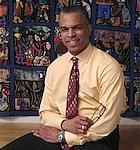Changing the Narrative About Young Black Men
A young black man is rolled on a gurney into an emergency room in an inner-city neighborhood. What assumptions do health care providers make about why he is there? What assumptions do journalists make?
Dr. John A. Rich laid out the basic assumption this way: "Young black men don't just get shot, they get themselves shot."
Rich was the keynote speaker to open the week-long National Health Journalism Fellowships. You can keep up with the fellowship seminars this week by following or commenting with the hashtag #nhjf, or here at The Fellowships Blog.
The chair of the Department of Health Management and Policy at the Drexel University School of Public Health, founder of the Young Men's Health Clinic in Boston and director of the Center for Nonviolence & Social Justice, he takes a broad view of public health and encourages journalists to do the same. He told the fellows this evening that uncovering health stories behind the all-too-often crime stories involving these young men takes patience, but if you sit down and ask young African American men who have experienced violence, "What happened?" eventually you can get past the common refrain "You know doc, I was in the wrong place at the wrong time." The phrase ultimately became the title of his book, Wrong Place, Wrong Time: Trauma and Violence in the Lives of Young Black Men, not because there are not deeper stories to be told, but because many young black men in inner-cities have no "right place" to escape violence and trauma.
The media too can do much to counter stereotypes, to "rehumanize" young African American men without excusing violent behavior. Consider context and consider the effects of recurrent trauma, Rich said. In an environment where violence is inescapable, resorting to aggression "can be both self-protective or, for some young people, the being of who you are when you don't have many other choices," he explained.
John A. Rich
What can journalists do to give young African American men space to tell their stories? Rich suggests that you can you cover the genesis of violence without excusing the behavior of perpetrators, "some acknowledgment" of the path that brings people to violent behavior. You can avoid initiating all the generalizations that happen with labeling a perpetrator as "a black man," by simply leaving race out when it is not the subject of the story.
"We face the same thing in medicine now," said Rich. Patients are often presented with their race attached. Does it suggest certain types of disease? Does it suggest poverty, discrimination, or stress? he asked. "It is factually accurate to say that 'he is black,' but the question is, is that causal?"
Dr. Robert K. Ross, the president and CEO of the California Endowment which funds the fellowship program said that if journalists want to write about race, they should, rather than mentioning it in passing. "Be comfortable in what story you want to tell," he said. "If you want to talk about race, then make it clear -- this is a story about race -- and call it out."
In his own interviews,, Rich said, "we simply leave as much open space for young people to talk." They phrase questions in an open way -- "Tell me what happened," or "Tell me about a time when..." "Sit and count to ten before asking the next question," he advised. Often interviewees will offer thoughtful answers to prior questions.

